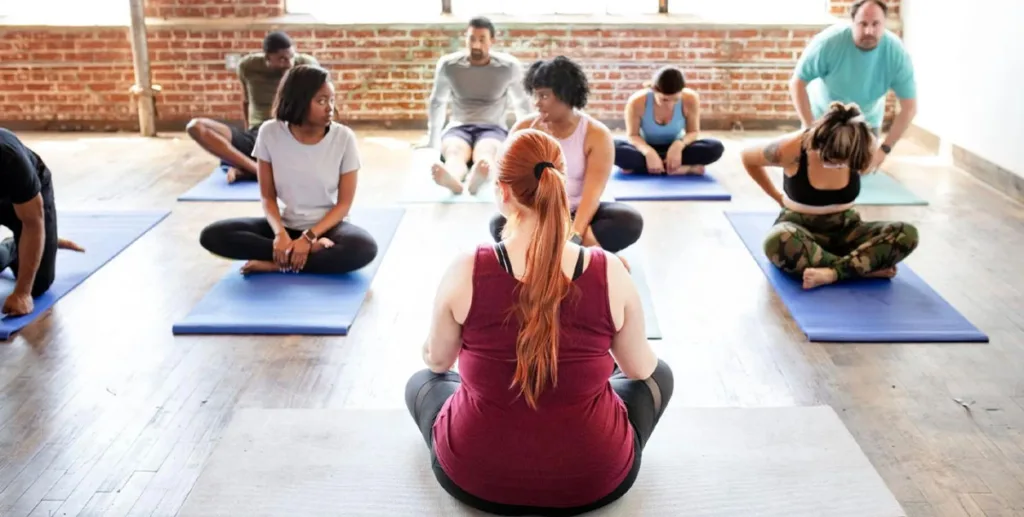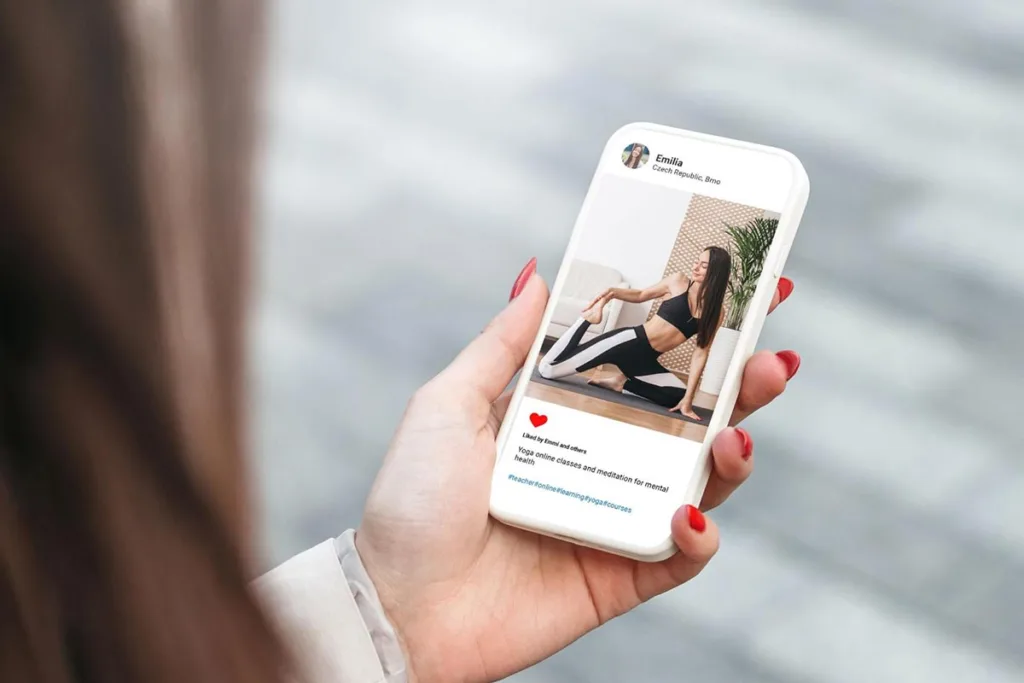11 yoga marketing ideas to grow your business
According to a survey by Yoga Alliance, 38.4 million Americans practiced yoga in 2022 and spent more than $21 billion on their yoga practice. That number is expected to grow even higher between 2024 and 2030, with Grandview Research predicting a 9.4% compound annual growth rate in the yoga industry.
There are plenty of potential clients for anyone launching a new yoga studio or looking to grow an existing yoga business. By developing an intentional yoga marketing strategy, you can reach more of those potential clients without overextending your budget.

Here are 11 yoga marketing and advertising tactics to help you grow your yoga business and attract new clients.
8 yoga marketing strategies to reach new students
There are a lot of marketing techniques you can use to promote your business, and for a small yoga studio owner who’s short on time, it can feel overwhelming. While paid ad campaigns can be part of your yoga marketing plan (more on that below), it’s typically best to start with lower-cost marketing techniques and move on to paid advertising after you’ve tried these essential strategies.
Fortunately, you don’t need to run all of these marketing campaigns simultaneously. Even if you tackle one thing at a time and build from there, you should see steady growth in the number of new clients you attract.
1. Build your online presence
One of the best ways to start marketing your yoga business is to ensure potential customers can find you when searching for yoga studios online. It’s important to have a yoga website where new students can read about your yoga studio, browse your class schedule, and learn about your yoga instructors. However, building a business website is just one part of your online presence.
To make your yoga studio come up online for more potential students, you should create a broad online presence by listing your business in as many places as possible.
Add your business to online platforms like Yelp, Bing for Business, and Google My Business. Create social media accounts on the platforms that your target audience is using, and add your studio and class schedule to yoga-specific platforms like Mindbody.
Make sure that your business name, logo, address and other contact information appear in the exact same way on all your online accounts. This helps potential clients know they’re looking at the same business on a different platform.
Including your business address on all your online accounts is also good for local search engine optimization (SEO), which can help your business rank near the top of the search results if a potential customer searches for a term like “yoga studios near me.” It also helps to include your business address and phone number on every page of your website, not just your homepage.
Start building your online presence by claiming your Yelp Business Page and updating it with your business information, like your address, phone number, and website. A recent study found that high-intent customers contact businesses they found on Yelp quickly—57% of users contact a business they researched on Yelp within a day—making this a good way to reach local customers.
Get found for free
Show up for any of the millions of customers on Yelp searching for a business like yours.

2. Send out email marketing
Email marketing is another digital marketing technique that you should do regularly, but “regularly” doesn’t have to mean every day or even every week. You can send out an email newsletter monthly or every couple of months.
Email marketing is a good way to stay in touch with past customers and encourage repeat business. And repeat customers can be your most valuable asset.
According to research by OneSignal, trying to sell to a new customer only has a 5–20% success rate, but trying to sell to an existing customer has a 60–70% success rate. So it’s much easier to bring past students back to your studio than it is to bring in new students for the first time.
To remind students to return for another class, you can email your class schedule or share helpful yoga tips to improve their practice. You can also use email marketing to announce special events, like a yoga retreat, yoga teacher training, or special one-time classes and workshops.
To grow your email list, ask new students to share their contact information, including their email address and phone number, when they sign up for their first class.
3. Start social media marketing

You’ve already created your social media accounts to build your online presence. Now you can start using them to reach new students.
Some social media marketing guides will tell you that you need to post 20 times a week on every social media channel to have any success. But that’s A) not possible for many small business owners and B) simply not true.
To create a successful social media marketing campaign, focus on the platforms your target customers use most—Facebook and Instagram are good places to start.
Nextdoor can also be a good app for local businesses because it helps you reach a hyper-local community. (It will mostly be people in your neighborhood and the surrounding neighborhoods who see your business’s posts.) TikTok is a good channel if you want to reach younger yogis because half of 18- to 29-year-olds say they use it, according to the Pew Research Center.
Once you’ve decided which social media channels you want to use, start posting content regularly. “Regularly” can mean once a month, once a week, or a few times a week. You can choose any schedule that works for you.
There’s plenty of opportunity to post yoga social media posts that educate and enlighten your followers. You can add photos from your yoga classes, share your class schedule, or give beginner-friendly tips on the proper alignment for different yoga poses. Use hashtags related to the topic of your post to reach more people.
When you post on a regular schedule—regardless of how frequent—it signals to the social media platform and to search engines that your account is still active. This helps you appear in results on the social media site and search engines.
If you’d like to grow your social media following even faster, you can pay to promote your content to your target audience (or people in your local community who are interested in other yoga and fitness accounts).
4. Offer a new student special
When potential students are looking to try a yoga studio, encourage them to pick your studio over other local options by offering a new student incentive.
Many yoga studios have new student pricing, offering discounts on students’ first yoga session or their first one-month unlimited package.
A discount on a single class may bring in more first-time customers. However, a discount on a one-month package might be more likely to create repeat customers since it encourages students to create a habit of attending yoga classes over the course of a month.
To find the most successful incentive for your business, try running each program for a certain length of time and see which has the biggest impact on your business.
5. Start a referral program
When it comes to yoga studio marketing efforts, your current students are your most valuable asset—and not just because of repeat business. Clients who have a good experience with your business are more likely to leave online reviews, provide testimonials, and recommend your studio to friends and family.
Even in the digital age, word-of-mouth marketing is the most trusted form of marketing. The Nielsen Trust in Advertising Report found that 88% of respondents trust recommendations from people they know more than any other form of advertising.
You can encourage more of your current clients to make these recommendations by starting a referral program. As part of a referral program, you’ll typically offer incentives to your current students for bringing in new students. Often you’ll offer an incentive to the new student as well.
For example, you might give your current students a 10% discount on their class or their next package if they bring a friend, and you might offer that same discount to the new student.
6. Create online classes and video content

Many yoga studios began offering online yoga classes during the COVID-19 pandemic out of necessity. But even now that students can return to the studio, there are still advantages to offering classes online.
Online classes allow students to practice with their favorite yoga teachers even when they can’t make it to the studio in person because of travel or schedule limitations. They can also be an extra revenue source, allowing more students to participate in every class. Moreover, virtual yoga classes can be a good addition to your content marketing strategy.
Content marketing is the process of creating helpful content—blogs, podcasts, or in this case, videos—that show your expertise in an industry. This helps build trust with potential customers and improve search engine rankings.
For yoga studios, online classes make great content. You can create free classes and paid classes (or classes that students can only access for a fee). A free online yoga class allows potential students to try before they buy. You can also decide between creating a library of video classes that are separate from your in-person classes or live-streaming classes so students can join in real time.
You can make shorter video content if you don’t want to create full-length classes. Videos to help students master a single asana, explain an essential vinyasa flow, or introduce your yoga instructors can all help market your business.
You can also repurpose any videos you make to use on your social media pages. In that way, content marketing can support your social media marketing efforts. It’s a win-win.
7. Partner with other local businesses
Grassroots marketing strategies are still effective in 2024. One of the best ways to promote your local yoga business is to partner with other businesses that have a similar demographic as you. Look for businesses that have wellness-focused clients but aren’t direct competitors.
For example, you likely won’t partner with another local yoga studio, but you might partner with a yoga retailer that sells yoga mats and clothes. Likewise, you might want to form partnerships with an acupuncturist, spa, aromatherapy shop, tea house, or even a vegan or vegetarian restaurant. (One study found that 8.3% of U.S. yoga practitioners are vegetarian, which is over six times higher than the general population.)
You could also partner with fitness studios that don’t offer yoga. For example, a spin studio might have students who would benefit from yoga as a form of recovery.
A partnership with another local business can take on many different forms. They may simply allow you to post flyers or display brochures in their business, or you may actively cross-promote each other’s brands in your email and social media marketing, or you might offer a discount to each other’s clients. You can create the partnership that works best for you both.
8. Participate in local community events

When you’re trying to reach local customers, it helps to be part of the local community. Look for wellness-focused community events in your area, and sign up to run a booth or give a demonstration.
A study by Uberall found that 55% of consumers feel more emotionally connected to a business in their area. You can establish that emotional connection by meeting with potential customers in person and showing that you’re involved in the community.
3 paid yoga advertising ideas to extend your reach
Whether you’ve used all the marketing ideas above and are ready to add to your marketing strategy, or you’re extremely short on time and need a quick advertising technique, paid yoga ads can help you reach more students.
If students discover your yoga studio through a paid advertising site, they’re likely to research your business online before they commit to attending one of your yoga classes. A report from Visual Objects found that 76% of consumers research a business’s online presence before visiting in person.
So if you want to get the biggest return on your investment, you should develop your online presence using the marketing tips above before you sign up for paid ads. Once you’re ready, these paid advertising techniques will put your business in front of potential customers.
1. Pay-per-click (PPC) advertisements
PPC ads are a cost-effective paid advertising strategy for small businesses. This type of ad may display for hundreds of potential customers, but you only have to pay for it when someone clicks on it, hence the name “pay-per-click.”
You can set up PPC ads on social media platforms with Facebook ads, Instagram Ads, TikTok ads, and so on. With these advertisements, you can set your ideal customer demographics by choosing the area they live in and even the interests they should have. Your advertisements will be displayed for users who match your target audience.
You can also set up PPC ads on search engines and online business platforms like Yelp. These PPC ads have prominent placements, such as above the organic search results when people in your area search for yoga businesses nearby.
For example, when you invest in Yelp Ads, your business page is placed in key places on Yelp.com and the Yelp mobile app, such as above or below relevant search results in the “Sponsored Results” sections and on your competitors’ pages. Businesses that use Yelp Ads get 4x more leads than those who don’t.
Get more leads
Reach more customers with placements on search and competitors' pages.

2. Retargeting ads
Retargeting ads are a subset of PPC ads. You’re also charged on a pay-per-click basis, but these ads display for people who have already shown an interest in your yoga business. They may have visited your website or one of your social media pages.
These ads remind potential customers of their interest in your business and can help them make the leap from researching to signing up for a class. Since they didn’t sign up on their first encounter, it can help to include a stronger call-to-action or an incentive in your retargeting ads.
For example, you might say something simple, like “Sign up for your first class today,” or provide an incentive, like “Sign up today to claim your new student discount.”
Retargeting ads can keep your yoga business top of mind for potential customers who are still considering signing up.
3. Direct mail

Direct mail is a form of print advertising you send to people living in your area. It’s often a postcard, flyer, or brochure, and it sometimes includes an incentive to encourage local customers to try out your yoga business. You may offer a discount or a free class.
The Future of Direct Mail Report for 2023 found that 76% of marketers consider direct mail more effective than any other marketing channel, and 81% of consumers said they engage with at least 20% of the direct mail they receive.
Direct mail can be a good way to get your business in front of your local yoga community. And because it’s based on physical addresses, you can target the potential customers who live closest to you and are most likely to visit your yoga studio.
Keep your yoga marketing plan flexible
There are many ways to market a new yoga business and expand your yoga marketing efforts for an existing business. Because so many customers research local businesses online, building your online presence is one of the best ways to start—and it’s a completely free advertising strategy.
From there, you can move on to any of the other yoga marketing ideas above. If you’re a yoga studio owner handling marketing efforts yourself, a little goes a long way. You can take on each marketing technique one by one and set schedules that work for you.
Learn more about online marketing and advertising to keep growing your business.